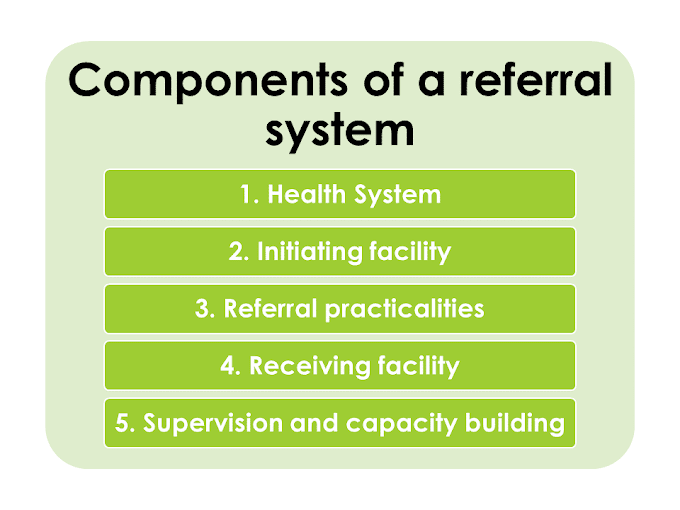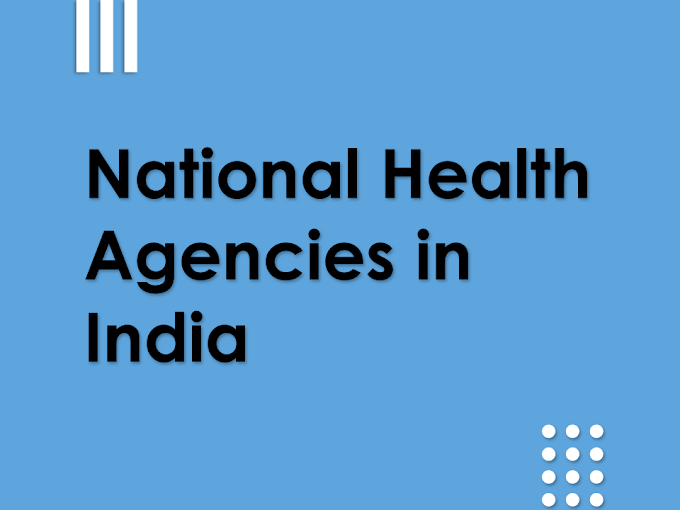The National Health Policy of 1983 and National Health Policy of 2002 have served well in guiding the approach for the health sector in the Five-Year Plans. Now 14 years after the National Health Policy 2017 is given by the government of India.
Definition of health policy
According to World Health Organization, Health Policy refers to decisions, plans, and actions that are undertaken to achieve specific health care goals within society.
National Health Policy 1983
The Ministry of Health & Family Welfare, Government of India, evolved National Health Policy in 1983 keeping in view the national commitment to attain the goal of Health for all by the year 2000.
Indicators to achieve Health for All
 |
Goals of National Health Policy 1983
|
Factors interfering with the progress towards Health for All
- Insufficient political commitment to the implementation of health for all.
- Failure to achieve equity in access to all primary health care elements.
- Slow socio-economic development.
- Difficulty in achieve intersectoral action for health.
- Unequal distribution of and weak support for human resources.
- Widespread inadequacy for health promotion activities.
- Weak health information system.
- Pollution, poor food safety and lack of water supply and sanitation.
- Rapid demographic and epidemiological changes.
- The continuing low status of women.
National Health Policy 2002
Significant changes in the determinant factors relating to the health sector, necessitating revision of the health policy, and a new National Health Policy-2002 was evolved by the government of India.
Main Objectives of National Health Policy 2002
- To achieve an acceptable standard of good health amongst the general population of country.
- The approach would be to increase access to decentralized public health system by establishing new infrastructure in the existing institutions.
- To ensure a more equitable access to health services across the social and geographical expanse of the country.
- Primacy will be given to preventive and first line curative initiatives at the primary health level.
- The policy is focused on those diseases which are principally contributing to disease burden such as tuberculosis, malaria, blindness and HIV/AIDS.
- Emphasis will be laid on rational use of drugs within the allopathic system.
Goals
To translate the above objectives into reality, the Health Policy has laid down specific goals to be achieved by the year 2005, 2007, 2010 and 2015. These are as given in Table.
National Health Policy 2017
National Health policy 2017 builds on the progress made since the last National Health Policy 2002. The developments have been captured in the document "Backdrop to National Health Policy 2017 - Situation Analysis", Ministry of Health and Family Welfare, Government of India.
Reasons for Emergence of New Health Policy
- Health priorities are changing.
- Emergence of a robust health care industry estimated to be growing at double digit.
- Growing incidences of catastrophic expenditure due to health care costs, which are presently estimated to be one of the major contributors to poverty.
- A rising economic growth enables enhanced fiscal capacity.
Primary aim of the National Health Policy 2017
The primary aim of the National Health Policy, 2017, is to inform, clarify, strengthen and prioritize the role of the Government in shaping health systems in all its dimensions- investments in health, organization of healthcare services, prevention of diseases and promotion of good health through cross sectoral actions, access to technologies, developing human resources, encouraging medical pluralism, building knowledge base, developing better financial protection strategies, strengthening regulation and health assurance.
Goal
Attainment of the highest possible level of health and wellbeing for all at all ages, through a preventive and promotive health care orientation in all developmental policies, and universal access to good quality health care services without anyone having to face financial hardship as a consequence. This would be achieved through increasing access, improving quality and lowering the cost of healthcare delivery.
Key Policy Principles
 |
| Key Policy Principles of National Health Policy 2017 |
Objectives
Improve health status through concerted policy action in all sectors and expand preventive, promotive, curative, palliative and rehabilitative services provided through the public health sector with focus on quality.
- Progressively achieve Universal Health Coverage.
- Reinforcing trust in Public Health Care System.
- Align the growth of private health care sector with public health goals.
Specific Quantitative Goals and Objectives
[A] Health Status and Programme Impact:
(a) Life Expectancy and healthy life:
- Increase Life Expectancy at birth from 67.5 to 70 by 2025.
- Establish regular tracking of Disability Adjusted Life Years (DALY) Index as a measure of burden of disease and its trends by major categories by 2022.
- Reduction of TFR to 2.1 at national and sub-national level by 2025.
(b) Mortality by Age and / or cause:
- Reduce Under Five Mortality to 23 by 2025 and MMR from current levels to 100 by 2020.
- Reduce infant mortality rate to 28 by 2019.
- Reduce neo-natal mortality to 16 and still birth rate to “single digit” by 2025.
(c) Reduction of disease prevalence / incidence:
- Achieve global target of 2020 which is also termed as target of 90:90:90, for HIV/AIDS i. e,- 90% of all people living with HIV know their HIV status, - 90% of all people diagnosed with HIV infection receive sustained antiretroviral therapy and 90% of all people receiving antiretroviral therapy will have viral suppression.
- Achieve and maintain elimination status of Leprosy by 2018, Kala-Azar by 2017 and Lymphatic Filariasis in endemic pockets by 2017.
- To achieve and maintain a cure rate of >85% in new sputum positive patients for TB and reduce incidence of new cases, to reach elimination status by 2025.
- To reduce the prevalence of blindness to 0.25/ 1000 by 2025 and disease burden by one third from current levels.
- To reduce premature mortality from cardiovascular diseases, cancer, diabetes or chronic respiratory diseases by 25% by 2025.
[B] Health Systems Performance:
(a) Coverage of Health Services:
- Increase utilization of public health facilities by 50% from current levels by 2025.
- Antenatal care coverage to be sustained above 90% and skilled attendance at birth above 90% by 2025.
- More than 90% of the newborn are fully immunized by one year of age by 2025.
- Meet need of family planning above 90% at national and sub national level by 2025.
- 80% of known hypertensive and diabetic individuals at household level maintain 'controlled disease status' by 2025.
(b) Cross Sectoral Goals Related to Health:
- Relative reduction in prevalence of current tobacco use by 15% by 2020 and 30% by 2025.
- Reduction of 40% in prevalence of stunting of under-five children by 2025.
- Access to safe water and sanitation to all by 2020 (Swachh Bharat Mission).
- Reduction of occupational injury by half from current levels of 334 per lakh agricultural workers by 2020.
- National/ State level tracking of selected health behaviour.
[C] Health Systems Strengthening:
(a) Health finance:
- Increase health expenditure by Government as a percentage of GDP from the existing 1.15% to 2.5 % by 2025.
- Increase State sector health spending to > 8% of their budget by 2020.
- Decrease in proportion of households facing catastrophic health expenditure from the current levels by 25%, by 2025.
(b) Health Infrastructure and Human Resource:
- Ensure availability of paramedics and doctors as per Indian Public Health Standard (IPHS) norm in high priority districts by 2020.
- Increase community health volunteers to population ratio as per IPHS norm, in high priority districts by 2025.
- Establish primary and secondary care facility as per norms in high priority districts (population as well as time to reach norms) by 2025.
(c) Health Management Information:
- Ensure district-level electronic database of information on health system components by 2020.
- Strengthen the health surveillance system and establish registries for diseases of public health importance by 2020.
- Establish federated integrated health information architecture, Health Information Exchanges and National Health Information Network by 2025.





3 Comments
Thanks for this information Beside the heart, many pieces of the chest that can cause chest torment incorporate the lungs, throat (neck), muscle, bone and skin. Thanks for this information Beside the heart, many pieces of the chest that can cause chest torment incorporate the lungs, throat (neck), muscle, bone and skin. Thanks for this information Beside the heart, many pieces of the chest that can cause chest torment incorporate the lungs, throat (neck), muscle, bone and skin. Thanks for this information Beside the heart, many pieces of the chest that can cause chest torment incorporate the lungs, throat (neck), muscle, bone and skin. Thanks for this information Beside the heart, many pieces of the chest that can cause chest torment incorporate the lungs, throat (neck), muscle, bone and skin.
ReplyDeleteIf you want more information so visit on this site=[url(=https://https://healthcarebloger.com/what-causes-chest-pain//]symptoms for chest pain[/url]
Dr. Sanchayan roy is the best Chest specialist in delhi NCR. Since Prof Sanchayan roy is a pilgrim of basic consideration and rest drug in India.Exactly when you are influenced by respiratory issues or are experiencing any of the recently referenced aftereffects, you need to advise a Pulmonologist or respiratory prepared proficient. Dr. Sanchayan Roy is a pulmonologist or respiratory master with various significant length of association. With his versatile capacity, ability and experience he gives a serious clinical evaluation and fitness to give wide extent of aspiratory care for people.
ReplyDeleteWhat types of diabetes can Affect You
ReplyDeleteWhat is the Normal level of Blood Sugar?
Long term complications of diabetes
Lower Blood Sugar level Symptoms
Best 10 Foods to control Diabetes and Low Blood Sugar